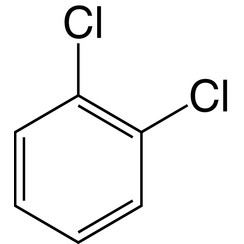You have no items in your shopping cart
1,2-Dichlorobenzene
1,2-Dichlorobenzene, or orthodichlorobenzene (ODCB), is an organic compound with the formula C6H4Cl2. This colourless liquid is poorly soluble in water but miscible with most organic solvents. It is a derivative of benzene, consisting of two adjacent chlorine atoms.
It is mainly used as a precursor chemical in the synthesis of agrochemicals, as a preferred solvent for dissolving and working with fullerenes, as an insecticide, and in softening and removing carbon-based contamination on metal surfaces.
1,2-Dichlorobenzene is obtained as a side-product of the production of chlorobenzene:
- C
6H
5Cl + Cl
2 → C
6H
4Cl
2 + HCl
The reaction also affords the 1,4- and small amounts of the 1,3-isomer. The 1,4- isomer is preferred over the 1,2- isomer due to steric hindrance. The 1,3- isomer is uncommon because it is a meta- compound, while chlorine, like all halogens, is an ortho/para- directors in terms of electrophilic aromatic substitution.
It is mainly used as a precursor to 1,2-dichloro-4-nitrobenzene, an intermediate in the synthesis of agrochemicals. In terms of niche applications, 1,2-dichlorobenzene is a versatile, high-boiling solvent. It is a preferred solvent for dissolving and working with fullerenes. It is an insecticide for termites and locust borers, historically used by the United States Forest Service to combat widespread bark beetle outbreaks.

